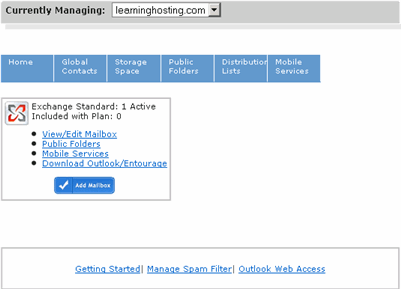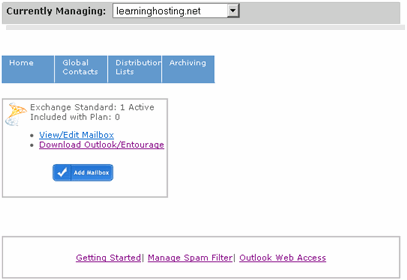1
Log in to SiteControl.
2
Click the Email link, and then the MS Exchange link.
3
The MS Exchange management interface provides a central place to access the main functionality of Exchange. Before beginning, make sure you are managing the proper domain by selecting it in the Currently Managing drop-down list.


![]() Getting Started: Provides a summary of the steps required to activate your Exchange service.
Getting Started: Provides a summary of the steps required to activate your Exchange service.
![]() Manage Spam Filter: Links to spam management interface.
Manage Spam Filter: Links to spam management interface.
![]() Outlook Web Access (OWA): A direct link to access Exchange Webmail using a browser.
Outlook Web Access (OWA): A direct link to access Exchange Webmail using a browser.
![]() Add Mailbox: Create new Exchange e-mail addresses.
Add Mailbox: Create new Exchange e-mail addresses.
![]() View/Edit Mailbox: Create, edit and manage mailboxes.
View/Edit Mailbox: Create, edit and manage mailboxes.
![]() Download Outlook/Entourage: This link allows you to follow some simple steps to automatically download and configure Outlook on your computer to work with MS Exchange. It also provides a link to download Entourage for Mac.
Download Outlook/Entourage: This link allows you to follow some simple steps to automatically download and configure Outlook on your computer to work with MS Exchange. It also provides a link to download Entourage for Mac.
![]() Global Contacts: Create and manage external Contacts so that they can be included in your Global Address Book.
Global Contacts: Create and manage external Contacts so that they can be included in your Global Address Book.
![]() Distribution Lists: Create a distribution list using use a single email alias. When a message is sent to a distribution list, it is automatically routed to the email address of each member in the list.
Distribution Lists: Create a distribution list using use a single email alias. When a message is sent to a distribution list, it is automatically routed to the email address of each member in the list.
![]() Archiving & Retention - Discovery: Store old and infrequently accessed e-mail on a MS Exchange server with no space or time limitation. In addition, enable Exchange's Legal Hold feature, which preserves a user's edited and deleted mailbox objects (e-mail, calendar items, tasks, etc).
Archiving & Retention - Discovery: Store old and infrequently accessed e-mail on a MS Exchange server with no space or time limitation. In addition, enable Exchange's Legal Hold feature, which preserves a user's edited and deleted mailbox objects (e-mail, calendar items, tasks, etc).
![]() Mobile Services: Activate mobile access to Exchange mailboxes using ActiveSync for Windows Mobile devices or BlackBerry Enterprise for BlackBerry devices. Manage mobile devices linked to an Exchange account.
Mobile Services: Activate mobile access to Exchange mailboxes using ActiveSync for Windows Mobile devices or BlackBerry Enterprise for BlackBerry devices. Manage mobile devices linked to an Exchange account.
![]() Storage Space: View/manage how much disk space is being used by mailboxes, and order additional space as needed.
Storage Space: View/manage how much disk space is being used by mailboxes, and order additional space as needed.
![]() Public Folders: This link allows you to set a user to Admin status, so that they can create and manage public folders for shared documents in either Outlook Web Access or Outlook.
Public Folders: This link allows you to set a user to Admin status, so that they can create and manage public folders for shared documents in either Outlook Web Access or Outlook.